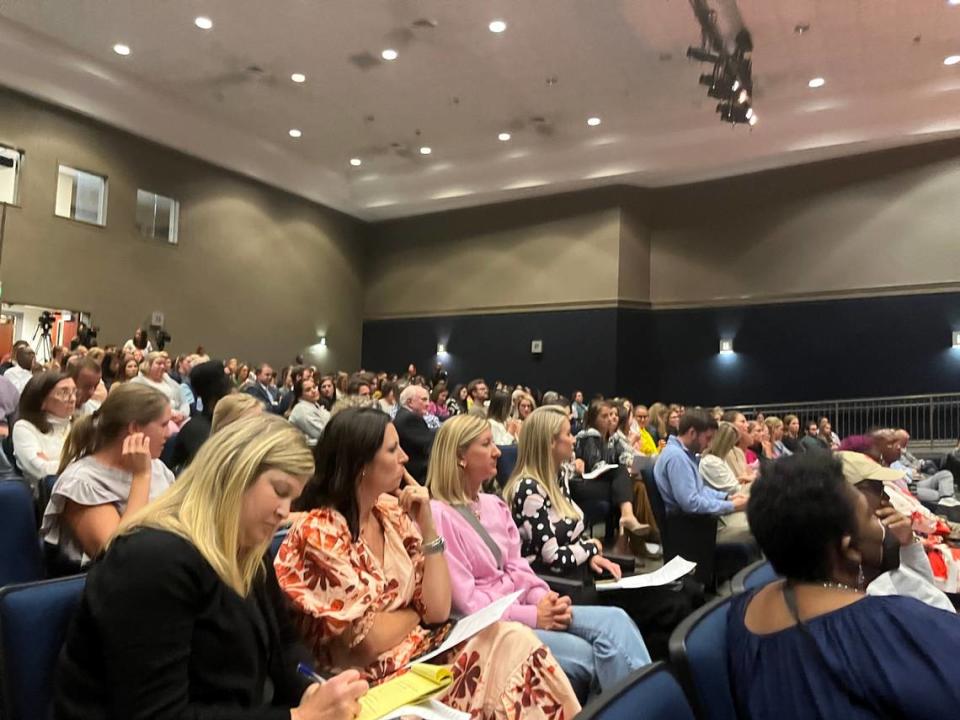Richland 1 has ‘little regard’ for teachers, parents and others say after sudden transfers
Richland 1 parents, teachers and some school board members expressed outrage Tuesday night over the district’s sudden reassignment of elementary school teachers, with one calling the change “inhumane.”
Some parents used the word “unconscionable” to describe the district’s actions, while others called the reassignments a “Band-Aid” on schools that are bleeding out teachers. Others simply asked the district for more transparency, and for the board to hold administrators accountable.
Board member Barbara Weston said teachers have been treated like “cattle or sheep,” herded from one place to the next within the district.
“Now they are allowing their voices to be heard,” Weston said.
Angry parents and others filled the Hopkins Middle School auditorium during Tuesday night’s board meeting to condemn the district’s transfers. Many did not fault the district’s attempts to fill the needs of some district schools, but rather the way it was handled.
Last week, 11 Richland District 1 teachers were told, with little notice, that they would be reassigned to different schools. The district said the changes were needed because of understaffing at some schools.
The change caused many to take to social media to criticize the district, including for a lack of communication.
The school district said the 11 teachers have been reassigned from seven elementary school campuses: Brennen, Satchel Ford, Meadowfield, Watkins-Nance, Logan, Bradley and Hyatt Park. These teachers have been moved to eight other elementary schools because of understaffing: E.E. Taylor, Watkins-Nance, H.B. Rhame, Caughman Road, Burton-Pack, Forest Heights, Mill Creek and W.S. Sandel.
Emily Luther, a parent of a student affected by the abrupt shuffle, said that when parents expressed concerns, they were met with “unresponsive platitudes.” Parents wondered why an alternative solution couldn’t have been explored before the teachers were moved.
“I am thankful that I have the benefit of a very resilient 5-year-old ... but I think that it is a terrible position for a school district to be in, that they are relying on the resiliency of children,” Luther said. “District administration has demonstrated that they hold their teachers and their families in little regard.”

Richland 1 officials said that the decision to move teachers was made after the 45th day of school, when the district had a “clearer picture” of student enrollment at each of its schools. The moves were based on student-teacher ratios. Despite the change, the district assured parents that moving teachers around is a common practice that happens every year. The district transferred 7 teachers in 2022, and 10 in 2021.
“We have to provide equity, balance and access in the district,” Kalu Kalu, the district’s director of certified employee services, said at Tuesday’s meeting.
According to the district, teachers were given a five-day transition period to acclimate and prepare for their reassignments. However, it is unclear when that transition period began.
The majority of the teachers were notified of their transfer Oct. 18, the day before the district’s fall break.
“Given the utter lack of notice the teachers were provided, the lack of notice principals were provided on either end of this reassignment spectrum, and the way that teachers were spoken to ... if we ignore that now we will lose more teachers,” said board member Robert Lominack.
Administration said the 11 teachers were the extent of the district’s teacher transfers, but Lominack expressed frustration with the presentation, and questioned its accuracy. He pointed out that Southeast Middle School lost a teacher, which was not included in the district’s data.
Kalu called it an “oversight.”
Parents and teachers weren’t the only ones to disapproved of Richland 1 Tuesday night.
Patrick Kelly, director of government affairs for the Palmetto State Teachers Association, said Richland 1’s teacher reassignments were not a failure of intent, but a failure of implementation.
“It is unfathomable that student enrollment projections were so off the mark they necessitated personnel reassignments of this scope and scale at such a late date,” Kelly said. “It is unprofessional and inhumane to have the first time staff learn about reassignments in their building be from a local news report.”
State Rep. Heather Bauer, D-Richland, attended Tuesday’s meeting too.
“Our kids in our district are suffering, and the root cause of all this comes down to the board, administration and leadership,” Bauer said. “The manner in which this has been done is so disrespectful to teachers, students and our children ... if this is how you treat your teachers in public, I cannot imagine what has happened behind closed doors.”
Ellen Weaver, state superintendent of education, submitted an op-ed to The State that criticized the district for its handling of the transfers. She noted that she and Gov. Henry McMaster can ask for a state inspector general’s investigation of the district if they are presented evidence of “potential malfeasance.” She also said she can take over the district or individual schools for academic under-performance.
The state department has already put the district on fiscal watch, Weaver pointed out.
“The seemingly sudden shift of several teachers between schools has raised hard questions in our community about the district’s personnel practices, communication, and leadership,” Weaver wrote.
The superintendent acknowledged the “headwinds” district leaders face across South Carolina, but said that school leadership is responsible for approaching difficult situations with compassion and consideration for teachers, students and parents.
“A school isn’t just a building a student walks into every day. It is an intentional and deeply interconnected community of students, families, educators, staff, and volunteers,” Weaver wrote. “And when poorly communicated decisions disrupt this ecosystem, trust is broken and ultimately, it is students who suffer.”

